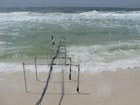Hurricanes and tropical storms are feared by many due to their destructive nature. Some, however, see the aftermath of these events as a means for exploration, specifically coastal engineers, geomorphologists and university research groups who seek to understand the dynamics of these natural occurrences and their impact on coastlines.
Interest in the geomorphology of the swash zone, an area of the beach alternately covered by water flowing upward and then backwashing, following a wave break, has increased over the years.
Diminishing Dunes
During late summer and early fall, hurricanes and tropical storms deliver large volumes of water and sediment onshore, eroding sand from dunes and changing the shape of beaches.
During the summer when storms are smaller, sand often accretes onto the beach from the offshore zone or sandbar by the onshore swash, carrying sand and water onto the beach, increasing its width both internally and externally. The backwash flow is almost eliminated because the beach absorbs the water and the sand is deposited. As sand dries out, wind transports it into the backing dunes, growing the beach in height and width.
The coastline changes most dramatically during the winter when large-scale storms take place. Hurricanes and tropical storms cause the ocean water level to rise, limiting infiltration and delivering large waves onto the beach.
While water level variation along transects is typically measured, little has been done to study the variation in water surface elevation over a larger area and how it relates to sandbar morphology.
Swash Zone Studies
Significant beach erosion and deterioration along Florida’s northwest coast occurred in 2004 and 2005 after hurricanes Ivan and Dennis and tropical storm Arlene touched down.
Funding was provided by Florida Sea Grant and the National Park Service to Texas A&M University’s Geography Department to perform studies on a barred beach in Northwest Florida affected by the storms.
The studies helped students become familiar with advanced measurement techniques to gain precise water level measurements and analyze the changes in beach characteristics at the scale of individual waves, tidal cycles and in response to storms. They also helped to determine how the asymmetry of the waves running up and down the beach affect the amount of sediment deposited on the beachface.
Pressure System’s KPSI Series 735 level transducers were chosen for the study. They were integrated into a larger system to help quantify wave phenomena.
“We chose Pressure Systems’ Series 735 for their ability to deliver highly accurate measurements,” said Chris Houser, assistant professor of coastal geomorphology at Texas A&M University.
3D Research
Three-dimensional water surface elevation as well as the effect rip currents have on beaches was studied. A large-scale examination analyzing sediment transport and beach recovery was also completed using Pressure Systems’ submersible hydrostatic level transducers.
“The results showed the rates of beach recovery, which were previously unattainable due to the lack of advanced water level measurement techniques available. By using the Series 735 transducer, studying beach morphology was easier, more accurate and allowed for a better understanding of managing coastal zones following hurricanes and tropical storms,” Houser said.
Source: Pressure Systems


